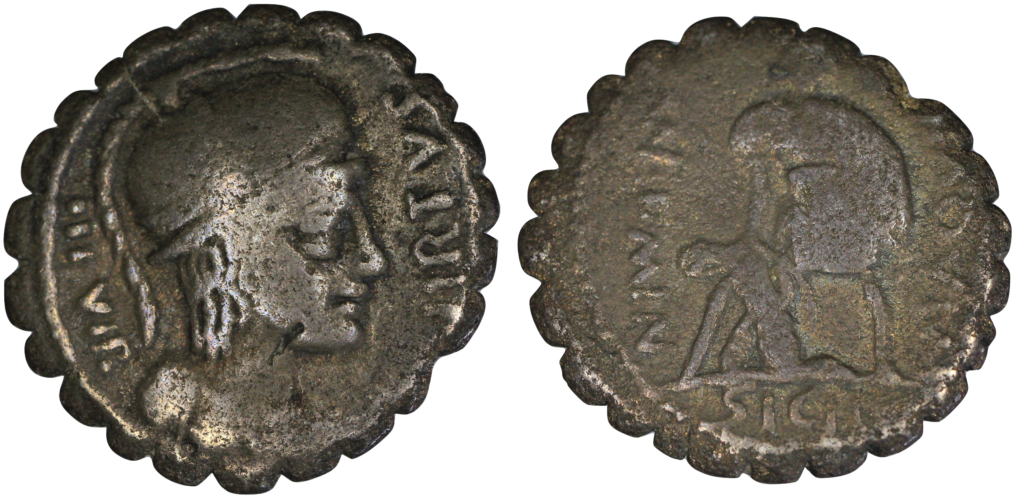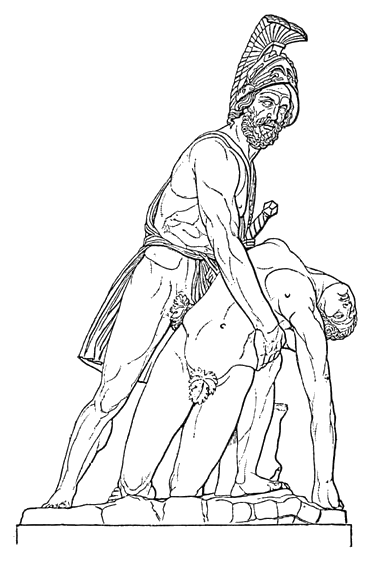
In case anyone might pick up this coin and wonder who issued it, the text is pretty insistent that you know. It reads MN AQVIL / MN F MN N, which utilises Roman name abbreviations to pack quite a lot in:
Manius Aquillius, son of Manius, grandson of Manius.
He’s quite keen that you should know who he is and, because of how status worked in ancient Rome, that you know therefore who his family are too. Actually, for reasons that we shall see, this is slightly shooting himself in the foot.
This Manius Aquillius wants us to know that he is the grandson of the Manius Aquillius who was consul in 101BC, so achieved the highest political office. His father, the moneyer’s great-grandfather (helpfully also named Manius Aquillius) had been consul in 129BC and had achieved signal honour of a triumph three years later, albeit with some rumours of some dodgy goings on: he was accused of maladministration, but was acquitted by bribing the judges. As we shall see, like father, like son.
Manius Aquillius (Great-grandfather, consul 129)
Manius Aquillius (Grandfather, consul 101)
Manius Aquillius (father)
Manius Aquillius (moneyer)
After his year in office as consul Manius Aquillius (grandfather) seemed the perfect man to sort out some trouble. Sicily was having a servile revolt, where the slaves were rising up against their overlords, led by a flute-player (shades of the pied-piper here?) called Salvius, who took the far grander sounding name King Tryphon. Testament to their unity of purpose is that after Salvius-Tryphon died, he was replaced by a new King Athenion, rather than the whole revolt falling apart.
At any rate Aquillius seems to have put the revolt down very effectively, though sympathies seem to lie with the defeated. Diodorus Siculus reports that those who were shipped back to Rome to die in the amphitheatres in fights with lions and other wild beasts cheated the people of their show by killing each other – a moral stance of which Diodorus strongly approved.
In 98, this Manius Aquillius (the grandfather) ended up being tried for extortion. The denouement of the trial, at which he was defended by Marcus Antonius (not to be confused with the Mark Antony) was farcical, really, but it worked. Cicero cites it rather sneeringly in his own speech against Verres (2.5.3). The defence whips Manius’ tunic open so the jury can see the scars on his body (all, naturally, on his front since he never turned his back on the enemy). The jury then all start to feel ashamed that the heroic general should have given so much for his country and barely escape, for them to then find him guilty of pocketing a few denarii. Even though he (probably) was guilty, they didn’t feel comfortable condemning a war hero.
In 88, he went to Asia to prosecute a war with Mithridates; defeated and captured, the ostentatious eastern potentate showed what he thought of Roman money by pouring molten gold down the consular legate’s throat.
So what does all of this mean for the coin? Well, it seems that Manius Aquillius the moneyer has skipped over the questions about his illustrious grandfather’s conduct and presents him raising the slumped female personification of Sicily (as she is identified by the inscription). She, beleaguered and haggard, is raised by the general back to her feet again after quite a time of it with the slave revolt. An association with popular contemporary imagery celebrating the suppression of Spartacus’ revolt may have suggested the scene to the family.
The head on the obverse is virtus, the female personification of that quintessentially masculine Roman ideal of manly courage and upstanding character. Manius has gone quite broad with his imagery here, presenting the grandfather as an unimpeachable military hero and associated him with Virtus personified – a tough sell if anyone remembered the history.
I very rarely critique Roman imagery – there is no point, really; it is more profitable to see what it tells you. Saying you don’t like a piece of Roman art really tells us nothing beyond what your taste is. But with that said, I don’t think the coin imagery is particularly successful. The scene of the soldier standing over the fallen woman is a little… well, gauche. Is he raising her, or has he caused her to fall…? His wielding of a shield and no sword at a stretch might connote protection over attack but it is pretty weak stuff. And why this moment? Why not show her raised up? Why not show her thanking him?
Iconographically, the imagery is closer to the type showing a personified place defeated (e.g. Nero and Armenia at the Sebasteion) than it is a heroic male and slumped figure (such as in the Pasquino group).
In a post death of the author world I wouldn’t want to suggest that clumsiness seems to have run in the family, but…
